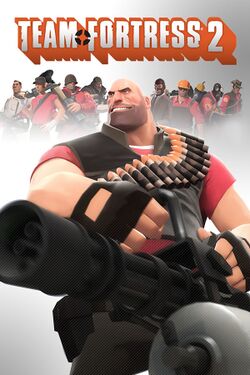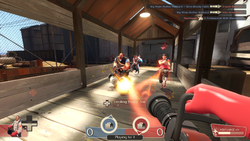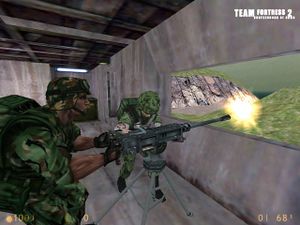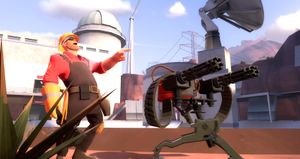Team Fortress 2/pt
| Team Fortress 2 | |
|---|---|

| |
| Informações básicas | |
| Data de lançamento: |
|
| Desenvolvido por: | |
| Editora: | |
| Distribuidor: | |
| Motor: | |
| Género: |
First person shooter |
| Modos: |
Multiplayer |
| Designer(s): |
John Cook, Robin Walker |
| Classificação: |
|
| Plataformas: |
Microsoft Windows, Xbox 360, PlayStation 3, Mac OS X, Linux |
| Media: |
Download, DVD, Disco Blu-Ray |
| Requisitos: |
|
Team Fortress 2 é um jogo first-person shooter de equipas multijogador desenvolvido pela Valve Software como parte do conjunto de jogos A Orange Box. Foi inicialmente lançado para Microsoft Windows, Xbox 360, e PlayStation 3 em Outubro 10, 2007. Depois, foi realizado como um só jogo em Abril 9, 2008, e em Junho 10, 2010, Team Fortress 2 foi lançado para o Mac OS X. As versões para PC e OS X adotaram um modelo "Grátis para Jogar" em Junho 23, 2011 com todo o dinheiro ganho sendo proveniente de uma loja virtual.
O jogo foi primeiro revelado em 1998 como sequela ao original Team Fortress, uma modificação do jogo Quake, mas atravessou vários processos de pensamento e edição. Em 1999, o jogo aparentemente tinha abandonado os estilos artisticos do Team Fortress Classic revelando-se um jogo mais realístico e militar. Contudo, o design continuou a evoluir no periodo de nove anos em que o jogo esteve a ser desenvolvido. O estilo final de Team Fortress 2 faz lembrar Team Fortress e Team Fortress Classic, e também inclui estilo visual semelhante a desenhos animados baseados na arte de Dean Cornwell, J. C. Leyendecker, e Norman Rockwell. Team Fortress 2 seque os costumes de filmes generados a computador, em particular, filmes recentemente feitos pelos Estúdios da Pixar, como Os Incríveis.
A aparente falta de informações sobre o desenvolvimento do jogo ao longo de 6 anos causou que fosse considerado "Vaporware", e foi sendo incluido na lista de vaporwares do Wired News', com outros outlets de jogos. Desde o seu lançamento, contudo, o jogo tem tido uma reputação tremenda e recebeu vários prémios.
Índice
Jogabilidade
Como os seus precedentes, Team Fortress 2 é centrado em 2 equipas opostas a tentarem cumprirem um objetivo. essas duas equipas são feitas para uma ser uma equipa de demolição e a outra uma equipa de construção como parte da história do jogo: Reliable Excavation Demolition (RED) E Builders League United (BLU). Os jogadores podem escolher uma das nove classes nessas equipas, cada uma com as seus pontos fortes, fraquezas, habilidades, e funções. Apesar das habilidades atuais serem bastante diferentes das habilidades das personagem dos Team Fortress originais, os elementos básicos de cada personagem continuam os mesmos.
Team Fortress 2 é um dos primeiros jogos da Valve que incorpora várias estatísticas detalhadas. Essas estatísticas incluem o tempo em que um jogador joga como uma certa classe, os seus pontos médios, ou o maior número de capturas ou objetivos cumpridos numa única ronda. Estatísticas persistentes indicam ao jogador em como ele está a melhorar, se como por exemplo um jogador quase bater o recorde de maiores danos causados numa única ronda. Team Fortress 2 também inclui várias Proezas para se completarem várias tarefas, como matar um certo número de jogadores ou acabar uma ronda em tempo recorde. Novos conjuntos de proezas foram lançados em cada update depois do lançamento principal do jogo. Esses adicionaram novas habilidades e armas a cada classe. Proezas completas aparecem no perfil da Steam do jogador ou no da Xbox LIVE.
Mapas
Nas versões de PC e OS X de Team Fortress 2, o lançamento principal só tinha seis Mapas feitos pela Valve, com várias dúzias a serem adicionadas ao longo dos anos pela Valve e pela comunidade de Team Fortress 2. Nas versões de consola, contudo, esses seis mapas originais, todos feitos pela Valve, continuam a ser os únicos disponíveis. Os mapas oficiais possuem um tema de "génios do mal" ou "retro-espionagem", com bases secretas escondidas em armazéns industriais, como super armas exageradas, tais como canhões de lasers e plataformas de lançamento de mísseis como objetivos.
Qunado um jogador joga um mapa pela primeira vez, um video de introdução mostra-os como completar os objetivos do mapa. O limite de jogadores num único servidor no PC e no OS X é de vinte e quatro, mas o limite pode ser editado até trinta e dois, enquanto o limite na Xbox 360 e na Playstation 3 é dezasseis.
Desenvolvimento
Origens
Originalmente desenvolvido como uma modificação "freeware" para o jogo Quake, Team Fortress 2 mudou para o mecanismo GoldSrc em 1998 depois da equipa de desenvolvimento Team Fortress Software – que consistia em Robin Walker e John Cook - foi contratada e empregada pela Valve. Nesse tempo, Team Fortress 2 era chamado "Valve's Team Fortress". Dada a contratação da Team Fortress Software, a produção aumentou e o jogo foi considerado um só titulo, e com contra-tempos, muito da comunidade de jogadores de Team Fortress já tinha comprado Half-Life somente na anticipação do lançamento de Team Fortress 2. O trabalho começou numa pequena porção lançada em 1999 como Team Fortress Classic. Notavelmente, Team Fortress Classic foi construido com o publicamente disponível GoldSrc Software Development Kit (SDK) como um exemplo de flexibilidade para a comunidade e a indústria.
Walker e Cook foram fortemente influenciados pelo seu contrato de 3 meses na Valve, e começaram a trabalhar a tempo inteiro no seu design, que estava sobre uma rápida transformação. Team Fortress 2 era suposto ser um jogo de guerra moderno, com uma hierarquia incluindo até comandos, com uma vista de pássaro sobre o campo de batalha; quedas de pára-quedas sobre território inimigo; comunicação por voz; e inúmeras outras inovações.
E3 1999
O novo design foi revelado ao público em 1999 no Electronic Entertainment Expo (E3) ond erecebeu vários prémios incluindo Melhor Jogo Online e Melhor Jogo de Ação. Neste tempo Team Fortress 2 tinha ganho um novo subtítulo, "Brotherhood of Arms", e os resultados de Walker e Cook trabalharem na Valve começaram a ser claros. Several new, and at the time, unprecedented technologies were on show: parametric animation; seamlessly blended animations for smoother, more life-like movement; and Intel's multi-resolution mesh technology dynamically reducing the detail of on-screen elements as they become more distant to improve performance (a technique made obsolete by decreasing memory costs, since today's games use a technique known as level of detail, which uses more memory but less processing power). No release date was given at the exposition.
In mid-2000, Valve announced that Team Fortress 2's development had been delayed for a second time. They put the news down to development switching to an in-house, proprietary engine that is today known as the Source engine. It was at around this time that all news ran dry, and Team Fortress 2 entered its notorious six-year vaporware phase, which was to last until July 13, 2006. During that time, both Walker and Cook worked on various other Valve projects – Walker was project lead on Half-Life 2: Episode One and Cook became a Steam developer among other things – raising doubts that Team Fortress 2 was really the active project that was being repeatedly described.
"Invasion" design

When the infamous Half-Life 2 source tree was leaked in late 2003, two Team Fortress 2 models were included along with the Team Fortress 2 source code – which was fully compilable. They consisted of an alien grunt and a very stylized, out-of-proportion human soldier. The code was interpreted by fans as making references to parts of the Half-Life backstory; however, the two leaked player models did not resemble any known style from the Half-Life series, leading many to think it was meant for Team Fortress 2.
The Source SDK was released with the Half-Life 2 source code, and also provided references to Team Fortress 2. Some code merely confirmed what was already believed, but other segments provided completely new information such as the presence of NPCs in multiplayer matches, the possibility of the game taking place in the Half-Life 2 universe, fixed plasma gun and missile launcher emplacements, and more.
None of the leaked information appears to have had any bearing on today's version of the game. This iteration was mentioned in an August 2007 interview with Gabe Newell by GameTrailers and a September 2010 interview with PC Gamer, in which he mentions "Invasion" as being the second phase of Team Fortress 2's development under Valve Software.
Final design
The next significant public development occurred in the run up to Half-Life 2's 2004 release: Valve's Director of Marketing Doug Lombardi claimed that Team Fortress 2 was still in development and that information concerning it would come after Half-Life 2's release. This did not happen, nor was any news released after Lombardi's similar claim during an early interview regarding Half-Life 2: Episode One. Near the time of Episode One's release, Gabe Newell again claimed that news on Team Fortress 2 would be forthcoming – and this time it was. Team Fortress 2 was unveiled again a month later at the July 2006 EA Summer Showcase event.
Walker revealed in March 2007 that Valve had quietly built "probably three to four different games" before settling on their final design. Due to the game's lengthy development cycle it was often mentioned alongside Duke Nukem Forever, another long-anticipated game that went through many years of protracted development and engine changes before being released.
The beta release of the game featured six multiplayer maps of which three contain optional commentary by the developers on game design, level design, and character design, and provide more information on the history behind the development.
Team Fortress 2 does not attempt the realistic graphical approach used in other Valve games using the Source engine such as Half-Life 2, Day of Defeat: Source, and Counter-Strike: Source. Rather, it uses a more stylized, cartoon-like approach "heavily influenced by early 20th century commercial illustrations." The effect is achieved using a special Valve in-house rendering and lighting technique making extensive use of 'Phong shading'. The development commentary in the game suggests that part of the reason for the cartoonish style was the difficulty in explaining the maps and characters in realistic terms. The removal of an emphasis on realistic settings allows these questions to be sidestepped. The game debuts with the Source engine's new dynamic lighting, shadowing and soft particle technologies, among many other unannounced features, alongside Half-Life 2: Episode Two. Team Fortress 2 was also the first game to implement the Source engine's new Facial Animation 3 features.
The art style for the game was inspired by J. C. Leyendecker, as well as Dean Cornwell and Norman Rockwell. Their distinctive styles of strong silhouettes and shading to draw attention to specific details were adapted in order to make the models distinct, with a focus on making the characters' team, class, and current weapon easily identifiable. Silhouettes and animation are used to make the class of a character apparent even at range, and a color scheme that draws attention to the chest area brings focus to the selected weapon.
Maps are designed with a neutral space between two bases. They are archetypal spy fortresses, but disguised as inconspicuous buildings to give plausibility to their close proximities. The maps have little visual clutter and stylized, almost impressionistic modeling, to allow enemies to be spotted more easily. The impressionistic design approach also affects textures, which are based on photos that are filtered and improved by hand, giving them a tactile quality and giving Team Fortress 2 its distinct look. The bases are designed to let players immediately know where they are. The RED base uses warm colors, natural materials, and angular shapes, while the BLU base uses cool colors, industrial materials, and orthogonal shapes.
Release
During the July 2006 Electronic Arts press conference, Valve revealed that Team Fortress 2 would ship as the multiplayer component of Half-Life 2: Episode Two. A conference trailer demonstrated the game's new graphical style featuring all of the original Team Fortress classes, pointed towards a more light-hearted and whimsical visual style as opposed to the dark, somewhat more traditional, military simulation that had originally been shown. Gabe Newell, the managing director of Valve, said that their goal was to create "the best looking and best-playing class-based multiplayer game."
A beta for Team Fortress 2 was released via Steam on September 17, 2007 for customers who pre-purchased The Orange Box and for those who activated their "Black Box" coupon, which was included with ATI HD 2900XT Graphics cards. In addition to The Orange Box customers, LAN gaming centers using the 'Steam for Cafe' system had the game installed and ready to play.
Team Fortress 2 was released October 10, 2007 as both a standalone product via Steam and at retail stores as part of The Orange Box – a game bundle pack priced at each gaming platform's standard price. The package also contains Half-Life 2, Half-Life 2: Episode One, Half-Life 2: Episode Two. and Portal. Valve offered The Orange Box at a $5 discount for those who pre-purchased it via Steam before the October 10 release, as well as the opportunity to participate in the final beta test of Team Fortress 2. The game receives constant, free updates that give the game new content, bug fixes, and additional features.
Team Fortress 2 became free-to-play on June 23rd, 2011 on Steam.
Critical reception
Team Fortress 2 was very well received by critics and consumers alike. Charles Onyett of IGN awarded Team Fortress 2 an 8.9/10 praising the quirky graphics and fun atmosphere, but criticizing the lack of extra content, like bots, as well as the removal of class-specific Grenades which were one of the defining features of the original Team Fortress. By contrast, PC Gamer UK praised Team Fortress 2 for removing the Grenade, continuing to compliment Valve Software for the unique nature of each of the game's characters. Despite some mild criticism over map navigation and the Medic class, PC Gamer UK awarded the game 94%. X-Play awarded The Orange Box with its highest rating (5/5) with nothing but good things to say about Team Fortress 2. Review aggregation site Metacritic ranks Team Fortress 2 as having received "universal acclaim", with an average critic review of 92%, based on 12 reviews by game critic sites, and a 9.6/10 rating based on user ratings. As of January 21, 2008, The Orange Box has a GameRankings score of 96.2% on the Xbox 360, making it tied for the highest ranked Xbox 360 game, and a score of 96.2% on the PC.
| Evaluation | Magazine / Website | View |
|---|---|---|
| 100 | AceGamez | The marriage of highly stylised retro-spy presentation, fresh, high octane action, deep and varied classes and the underlying twinkle of humour in its metaphorical eye make Team Fortress 2 far more than just your average fragfest. Long after the novelty of the graphics wears thin, we are left with a refined and accessible multiplayer game that simultaneously cultivates new players whilst retaining enough depth to accommodate even the hardiest of veterans. |
| 100 | GameSpy | At this point, it's a leading contender for our Multiplayer Game of the Year, and whether you pick it up as part of the Orange Box package or on its own via the Steam digital download service, it's worth every penny. |
| 96 | Cheat Code Central | Team Fortress 2 is a must-buy. It's the most fun you'll have being shot at in a long time. |
| 96 | YouGamers | When the biggest flaw of the game is that it gets a bit repetitive after the first hundred or so hours of play, you know you have something special. |
| 94 | PC Gamer UK | Rich, gorgeous and endlessly fun. |
| 93 | Computer Games Online RO | Watch out though, if you get the taste of it, eventually you might end up telling your boss, "Take it like a man, shorty!" |
| 93 | PC Zone UK | The perfect integration of classes, the character and level design, the visuals, and the level of accessibility. [Dec 2007, p.64] |
| 92 | GameZone | This game makes me laugh even when I'm losing… an impressive feat. |
| 90 | Eurogamer | The game also does a lovely job of framing your relationship with other players and nurturing them. |
| 90 | GameDaily | With a whacky, off-the-wall cartoon style, Team Fortress 2 provides excellent class based multiplayer action. TF2's classes are unique from each other and stand out to fulfill specific roles, but flexible enough to adapt to changing situations. |
| 90 | Play (Poland) | The ideal online shooter: average player can enter the fray and even hurt somebody, while pros will be grinding away milliseconds from the time to carry the suitcase on 2Forts. And all thanks to the fact that among the nine classes there is exactly zero useless ones. The only serious drawback is the disgracefully low number of maps: only six. [Dec 2007] |
| 90 | 1UP | I loved, loved TF2's cosmetic makeover. "Cartoon come to life" isn't compliment enough. Some cartoons are better animated, more distinctively stylized than others – and, by analogy, this is among the best. |
| 90 | PALGN | Team Fortress 2 is, at heart, a gloriously simple game that's been created with style, panache and an undeniable love of gaming. It's the kind of game that you want to show to people who don't play games so that they understand and then either get involved or go away. There is life before Team Fortress 2, and there is life after. After is better. |
| 90 | GamerNode | The action is fast-paced and furious, the game's presentation is hilarious and exciting and the gameplay is very easily approachable. Experiment with a few classes or stick with one, but do anything to get your hands on TF2. It'll be an online experience you won't forget. |
| 89 | IC-Games | It's one hell of a game. With its powerful artistic style and blazingly quick, yet accessible gameplay, it's enough to melt the icy cynicism imprisoning the hearts of even the most jaded among us. That being said, it's not the most complex shooter out there. |
| 85 | The New York Times | Team Fortress 2 is a beautifully designed game with a visual style reminiscent of old Warner Brothers cartoons, and battles that combine strategy with frenetic action. The only real flaw is the documentation, which is far too skimpy to be of any help at all in learning the intricacies of each soldier class. |
| 85 | GameSpot | Team Fortress 2 sets a brilliant stage for its signature brand of class-based multiplayer mayhem. |
Awards
Team Fortress 2 has won several awards since its release. In its "Best of 2007" awards, IGN.com honored the game with an award for "Best Artistic Design" for the PC. Additionally, Team Fortress 2 received awards for "Best Multiplayer Experience (PC)", and "Best Artistic Direction (PC)" from 1UP.com in its 2007 editorial awards. The game also won "Best Multiplayer Game of the Year" both on the PC and on any platform in GameSpy's 2007 Game of the Year awards along with an award for "Most Unique Art Style".
External links
- The Team Fortress 2 page at the official site of The Orange Box.
- Valve Software official site.
- The Official Team Fortress 2 Blog
- The Team Fortress 2 Game Hub on Steam.
Major game updates (oldest to newest):
- The Gold Rush Update (04/29/2008)
- The Pyro Update (6/19/2008)
- A Heavy Update (8/19/2008)
- The Scout Update (2/24/2009)
- The Sniper vs. Spy Update (5/21/2009)
- Classless Update (8/13/2009)
- Hallowe'en Special (10/29/2009)
- WAR! Update (12/17/2009)
- 119th Update (04/29/2010)
- The Mac Update (06/10/2010)
- The Engineer Update (07/08/2010)
- The Mann-Conomy Update (09/30/2010)
- Scream Fortress Update (10/27/10)
- Australian Christmas (12/17/10)
- The Hatless Update (04/14/11)
- The Replay Update (05/05/11)
- The Über Update (06/23/11)
- The Manniversary Update (10/13/11)
- Very Scary Halloween Special (10/27/11)
- Australian Christmas 2011 (12/15/11)
- Pyromania Update (6/27/12)
- Mann vs. Machine Update (8/15/12)
- Spectral Halloween Special (10/26/12)
- Mecha Update (12/20/12)



